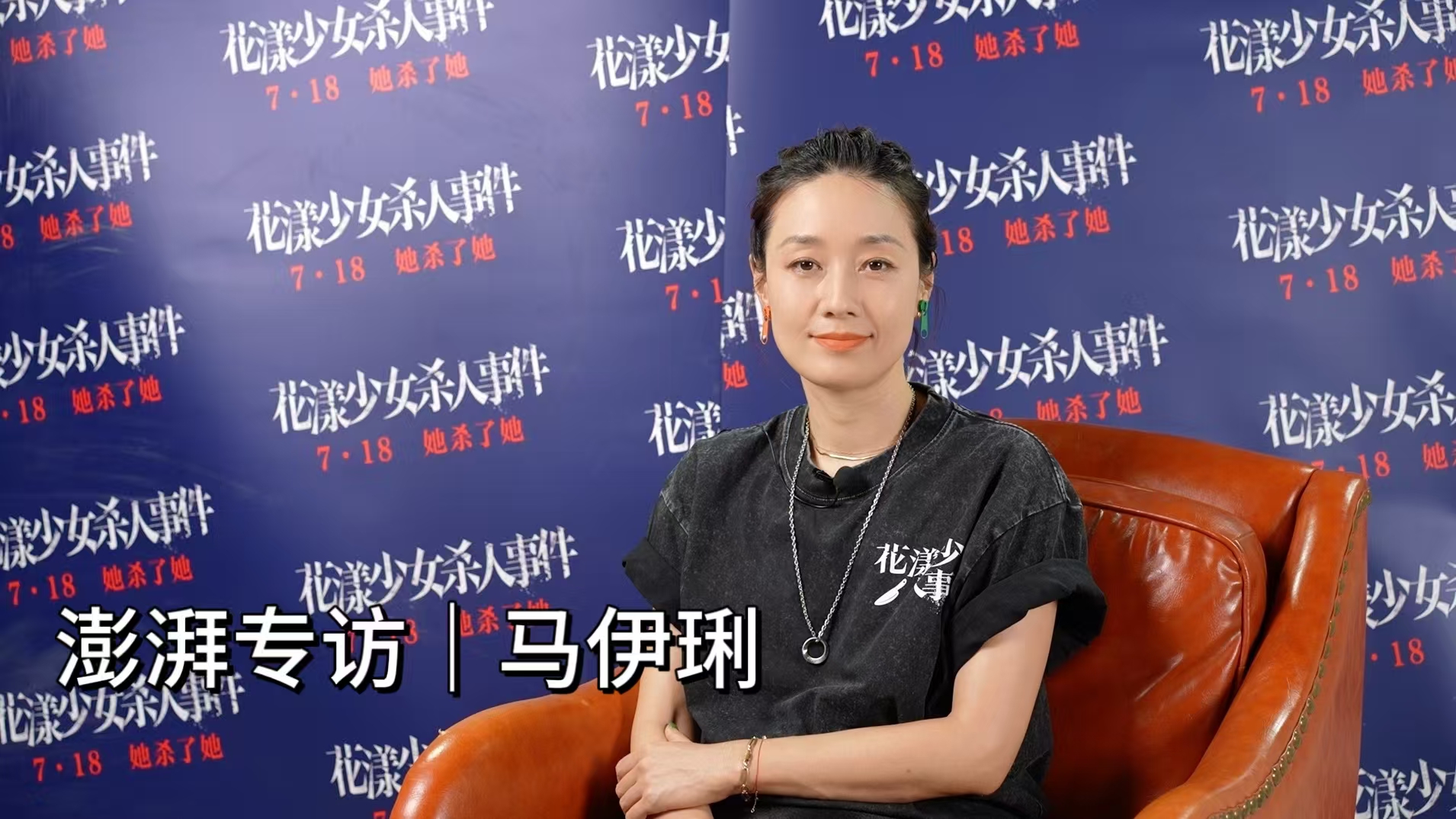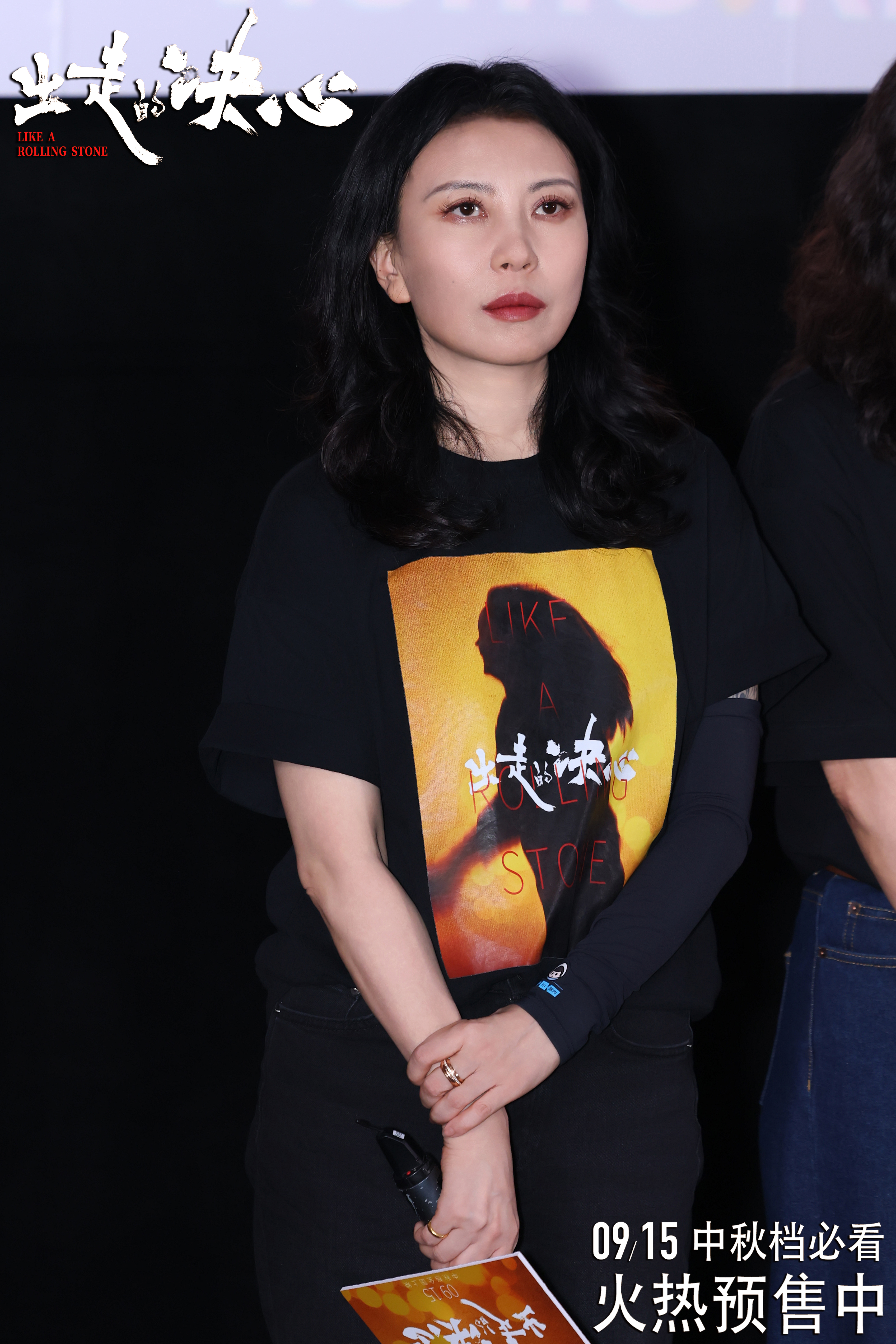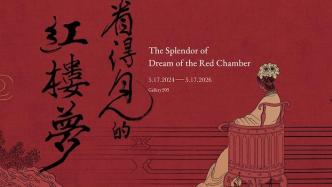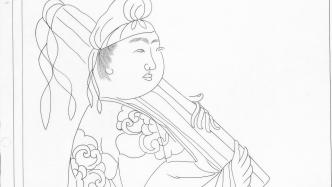
In recent years, the relics of stone inscriptions of the Sui and Tang Dynasties have emerged in an endless stream, and treasures have repeatedly appeared, including various collections of tombs, religions, buildings, etc., many of which are unprecedented boutiques. It brings both research value and image value to the academic world, and also brings unexpected aesthetic value to the art world. What is aesthetically astonishing is that the Shaanxi Han and Tang Stone Carvings Museum has a set of eye-catching line depictions on the coffin wall, which not only describe the descriptions of painters who have penetrated thousands of years, but also record the new appearance of women in the ever-changing world.
This paper adopts nine newly released depictions of the coffin walls of the Tang Dynasty to study the "thick, beautiful and plump" female images that artists in the heyday of the Tang Dynasty devoted themselves to depicting. Each painting has its own characteristics. Flowers and birds, all complement each other, each figure is beautiful and charming, and the posture of holding objects is concrete and vivid, which not only naturally expresses the living conditions of the women at that time, but also reflects the spiritual image of the ladies in the upper mansion. It embodies the rational characteristics of mature aesthetics in oriental society, and is also a response to the style and artistic realm of the times.
1. The depiction of the screen walls of the stone coffin
There are nine paintings on the inner and outer walls of the stone coffin on display, each 119 centimeters high and 65 centimeters wide. Although the coffin wall is damaged and cracked, the overall view is "house garden + lady image + artistic expression". The artist used ingenuity to pave the beauty of sculpture art. His original intention was to arrange a garden-like landscape for the owner of the tomb that he once enjoyed. That is, the gardens of typical high-ranking officials and wealthy households live comfortably and luxuriously, but they give us an opportunity to see the fate of women in the historical process. Those ladies and maids are vividly displayed in front of people. The description not only adapts to the real image of that era in the way of pictures, but also reproduces the aesthetic style of the era of "thick, beautiful and fat" in the atmosphere of the prosperous Tang Dynasty in the image description.
The painter is good at using bas-relief techniques, and there are paintings of beautiful women carved on both sides of the coffin wall, as if entering the historical picture through artistic connection.
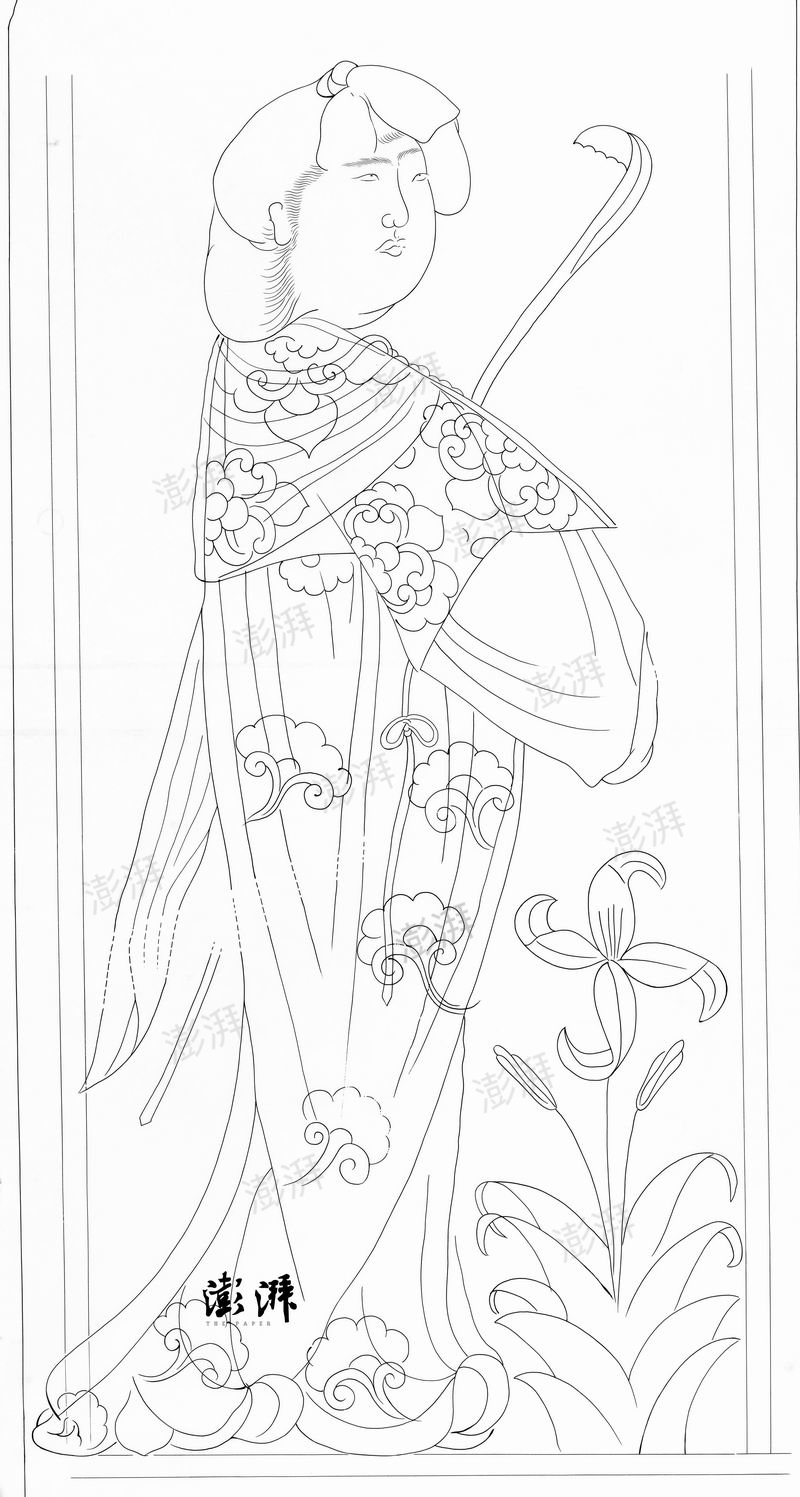
Figure 1: A fat woman with a haircut standing next to day lilies holding a scratching stick
In the first picture, the artist chooses a back view of a lady standing sideways to occupy the picture. The lady combs her hair in a bun, holds a multi-purpose Ruyi long stick in her hand, wears tulle and silk on her shoulders, wears a cross-neck and wide-sleeved undershirt, and a floor-length skirt printed with cloud flowers. This lady twists her plump body The body shows a round face, and a cluster of daylilies is drawn on the lower right of her, which not only marks the lush vegetation in the garden, but also contains the painting meaning of "listening to the sound of birds and waiting for the flowers to bloom". (figure 1).
In the second picture, a lady with a slanted back looks more like a man wearing a head-dress. She wears men's clothing with a braided waist. Although the lady's eyebrows and eyes are not viewed from the front, she bends her back, turns her head to the left, and unfolds the scroll with both hands. Calligraphy works, the scroll is covered with cursive characters, it is difficult to identify what is written, only the word "Miscellaneous Collection" is clearly visible (Figure 2). It is very likely that it is an elegant collection of literati and refined scholars who recite poems and compose Fu when they are invited to appreciate the red flowers during the flowering period.
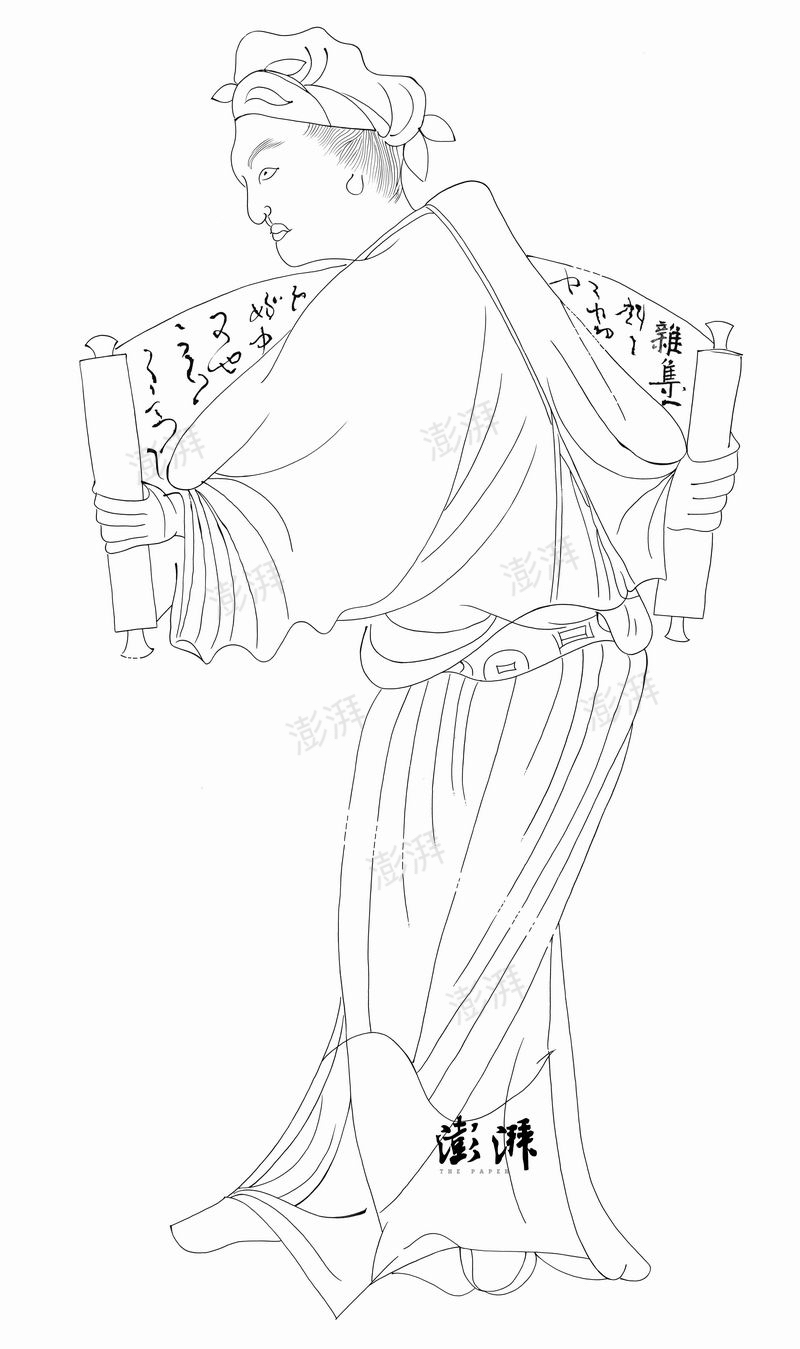
Fig. 2 The cursive calligraphy scrolls of "Miscellaneous Collection" exhibited by ladies in men's clothing
The third picture is a maid in men's clothing wearing a high bun, with a streamer hanging down behind the bun, wearing a round-neck robe, a rice-shaped leather belt around the waist, a round face with slender eyebrows and long eyes, and a big nymph fluttering above her forehead. The maid stood among the flowers, holding a long rope up and down with both hands, and a bird with an orris in its mouth was tied to it, as if it was frightened and was about to spread its wings and fly away. There are two bunches of parallel flowers at the bottom of the picture, setting off the whole picture and living in the garden (Figure 3). The whole picture has the artistic conception of "the birds are startled and staring at the dawn, and the smiles of flowers are not related to spring".
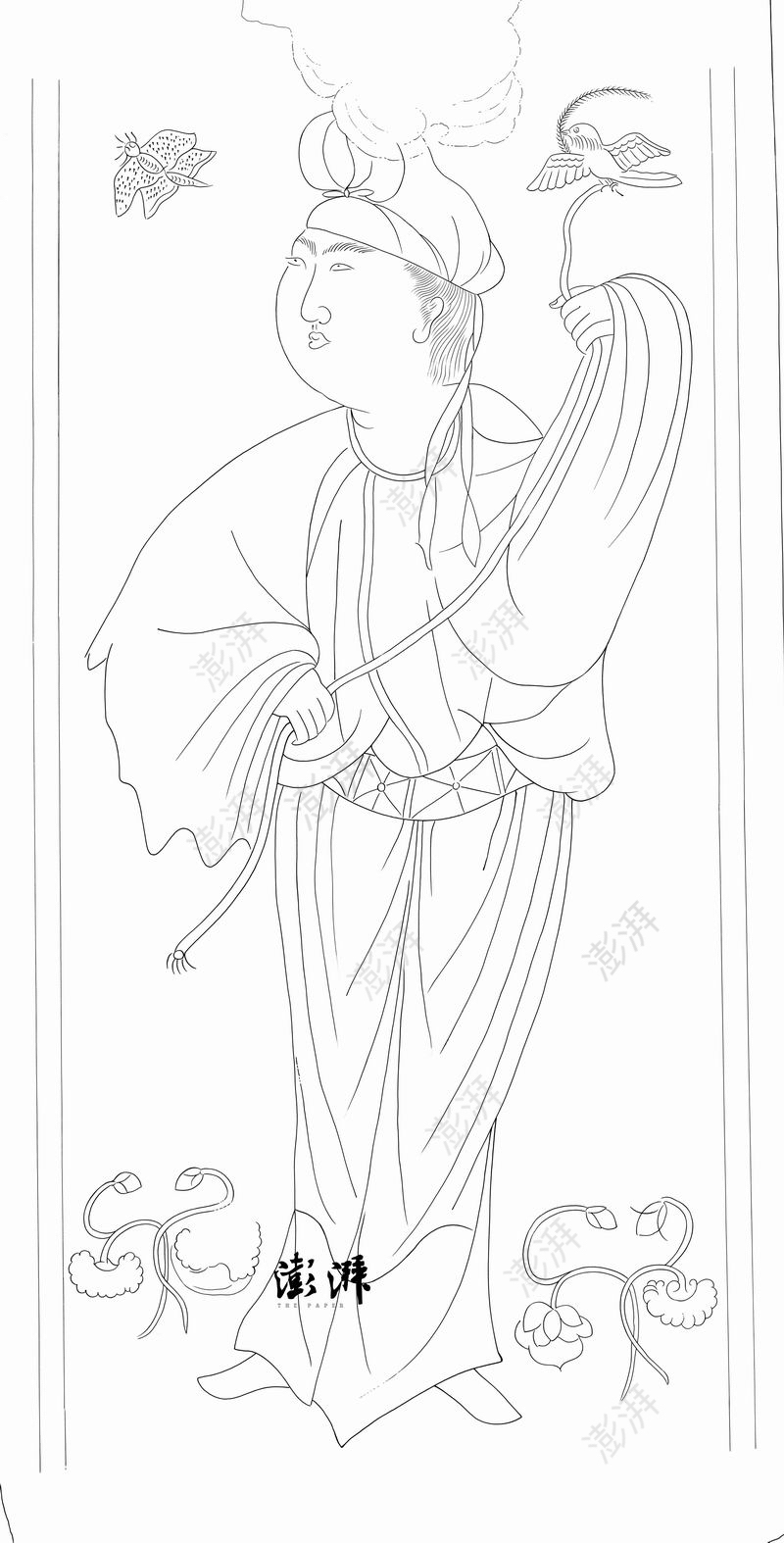
Figure 3. The maid in men's clothing wears a high bun and is standing in a bush of flowers, pulling a rope with both hands to hold a grass bird, while watching the flying butterflies.
The fourth picture is a typical picture of a lady. The lady in a bun, wearing a long skirt with a peony flower pattern, is happily walking into the garden, turning her head to the right, with her small mouth slightly open, as if Singing or chanting, it must not be a maid working as a handyman. The families of officials and eunuchs in the Tang Dynasty often kept a group of jiyue. At present, there are more than 40 kinds of songs sung by the jiyue. In addition to "Luo" and "Fire Phoenix Song", he also created "He Manzi", "Wang Fu Song", "Golden Thread Clothes", "Bamboo Branch Ci", "Weicheng Song", etc., many of which belong to the new sound of Hu Qu (Figure 4).

Figure 4. Ladies with hair combed in a Japanese bun and a silk rope in their hands, and a peony flower pattern printed on the floor-length skirt
In the fifth picture, a maid wearing a round-neck men's suit with a soft scarf on her head is holding a violin kite on her left shoulder, holding the violin in both hands and standing sideways. It seems to be preparing for the performance in the garden. The maid's gorgeous coat is particularly eye-catching. It is not an ordinary round-neck shirt but a wide-sleeved robe with large clusters of flowers. Below the belt is a lower skirt with two patterns of cross flowers and snowflakes (Figure 5).
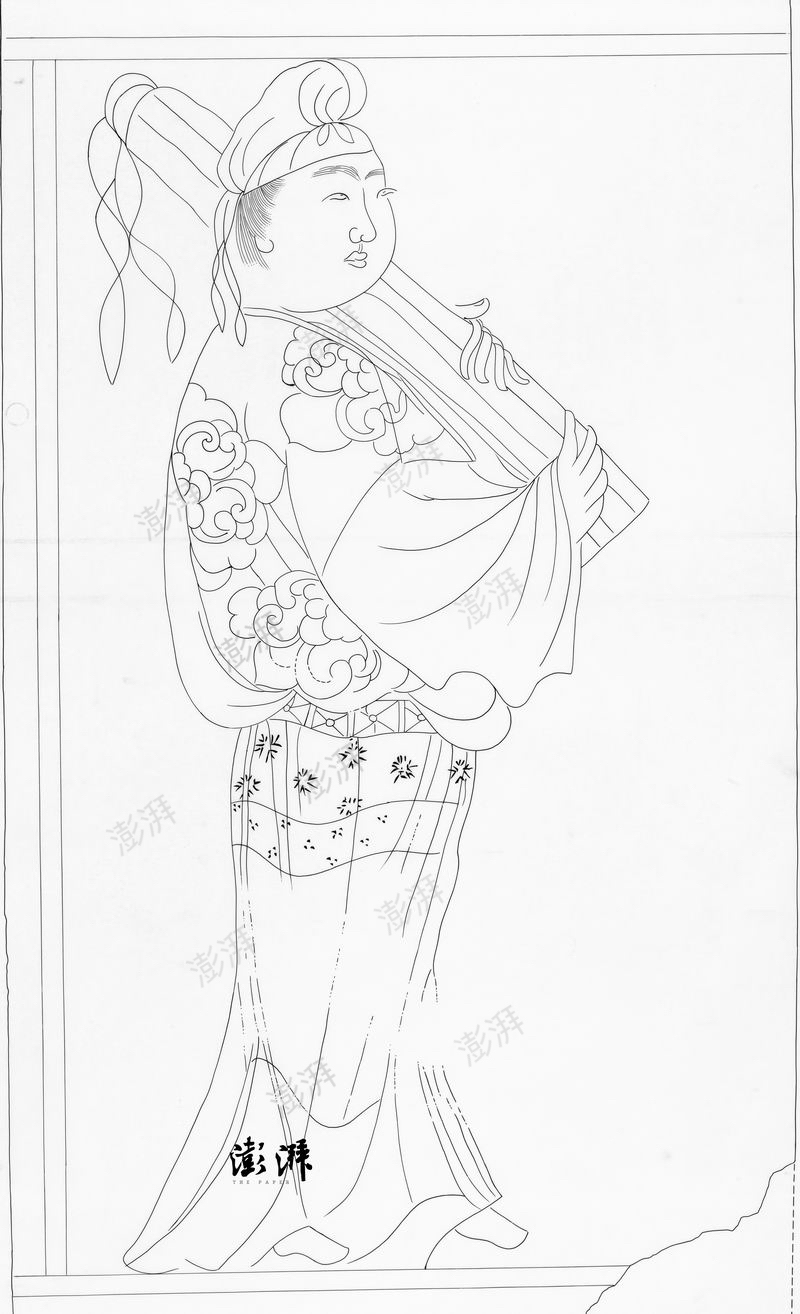
Figure 5. A maid in men's clothing stands with a guqin on her shoulders, wearing a tunic-flowered wide-sleeved gown, a leather belt around her waist, and pointed-toed flat shoes on her feet
In the sixth picture, the maid in men's clothing wears a soft scarf, a round-neck mid-length shirt, and pointed-toed flat shoes. She holds a roll with a cloth cover in her left hand, or a picture scroll or music score, and she is taking out an ink stick with her right hand (Figure 6). The editor of the catalog believes that "the right hand seems to be pulling out the wat board from the cuff", which may be a misjudgment, not only inappropriate for the identity but also inappropriate for the situation. I think it should be observed in conjunction with the maid holding the roll cloth cover in her left hand, and it should be the ink ingot in her right hand, and the book and ink serve the master to write poems in the garden. In the Tang Dynasty, the ox tongue ink was more than a foot long, and it was very famous at that time.

Figure 6. The maid in men's clothing holds a painting tube silk bag in her left hand and a beef tongue ink ingot in her right hand.
In the seventh picture, under a big old tree in the garden, a lady in a round-neck and wide-sleeved robe sits on a low stool and concentrates on playing the guqin. It seems that the environment of "slow sound and heartbeat" has attracted the winged birds in the sky. The flower branches with ribbons in their mouths fly into the distance (Figure 7). This painting not only depicts a lady putting the guzheng on her legs to tune and pluck the strings, but also a pair of mandarin ducks are drawn at her feet. "Flowers Blooming Together" has a happy private life.
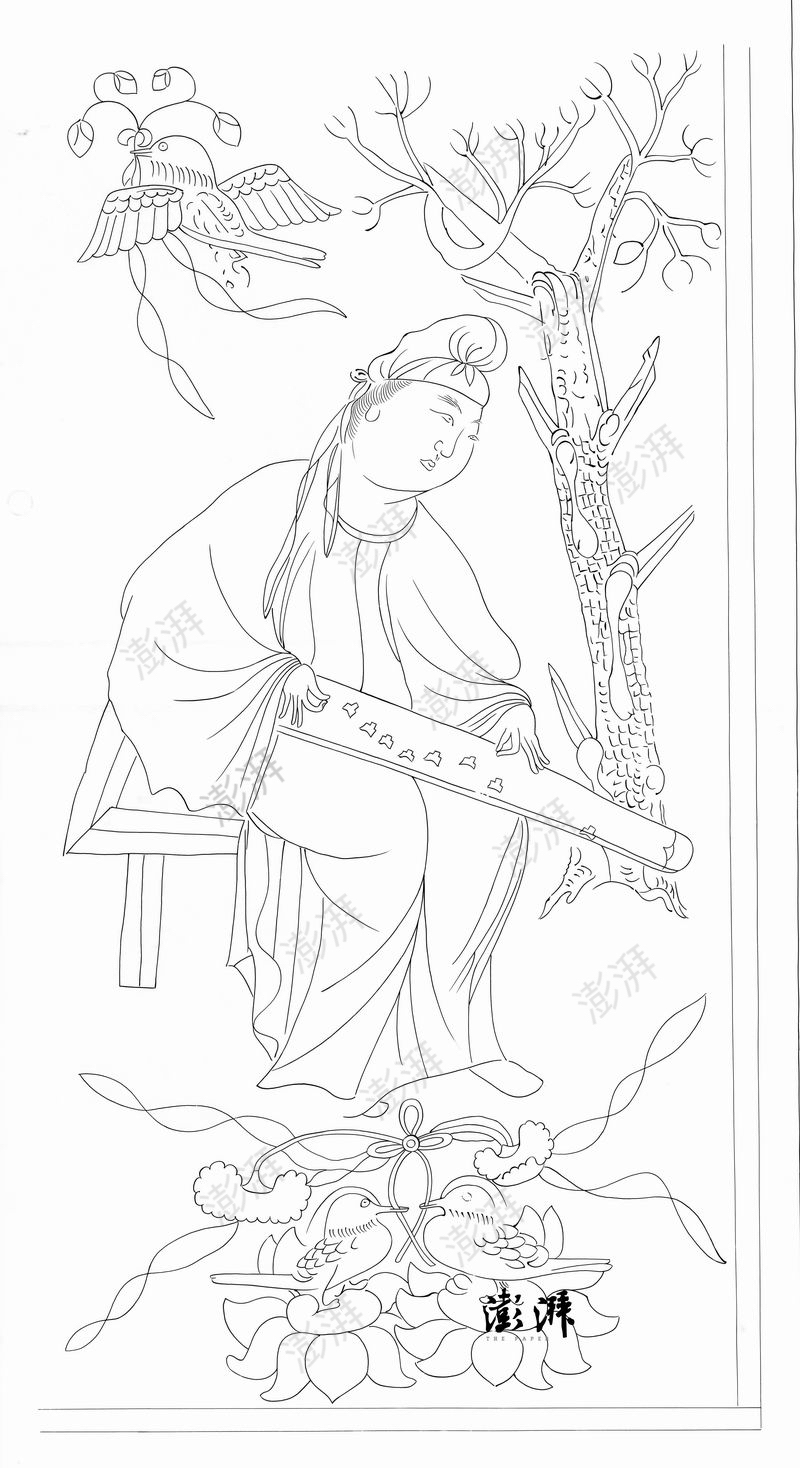
Picture 7 Under the tree, men's clothes and ladies wearing Futou, leaning over to sit on a stool and play the piano on their legs, holding flower branches in the sky with flying birds, and mandarin ducks holding flower branches in the ground symmetrically facing each other.
The eighth picture is the most wonderful. A lady wearing a high bun, wearing a long skirt covered with rice-shaped stars, with slightly opened eyes on her round face, stands holding a golden birdcage in both hands, which seems to be placed on her chest. Whistling to amuse the birds (Figure 8). In particular, the painter depicts the lady orchid gently lifting the top of the cage with one finger, and holding the bottom of the cage with the other hand, as if meeting a swallow fairy, a real picture of playing with birds for fun.
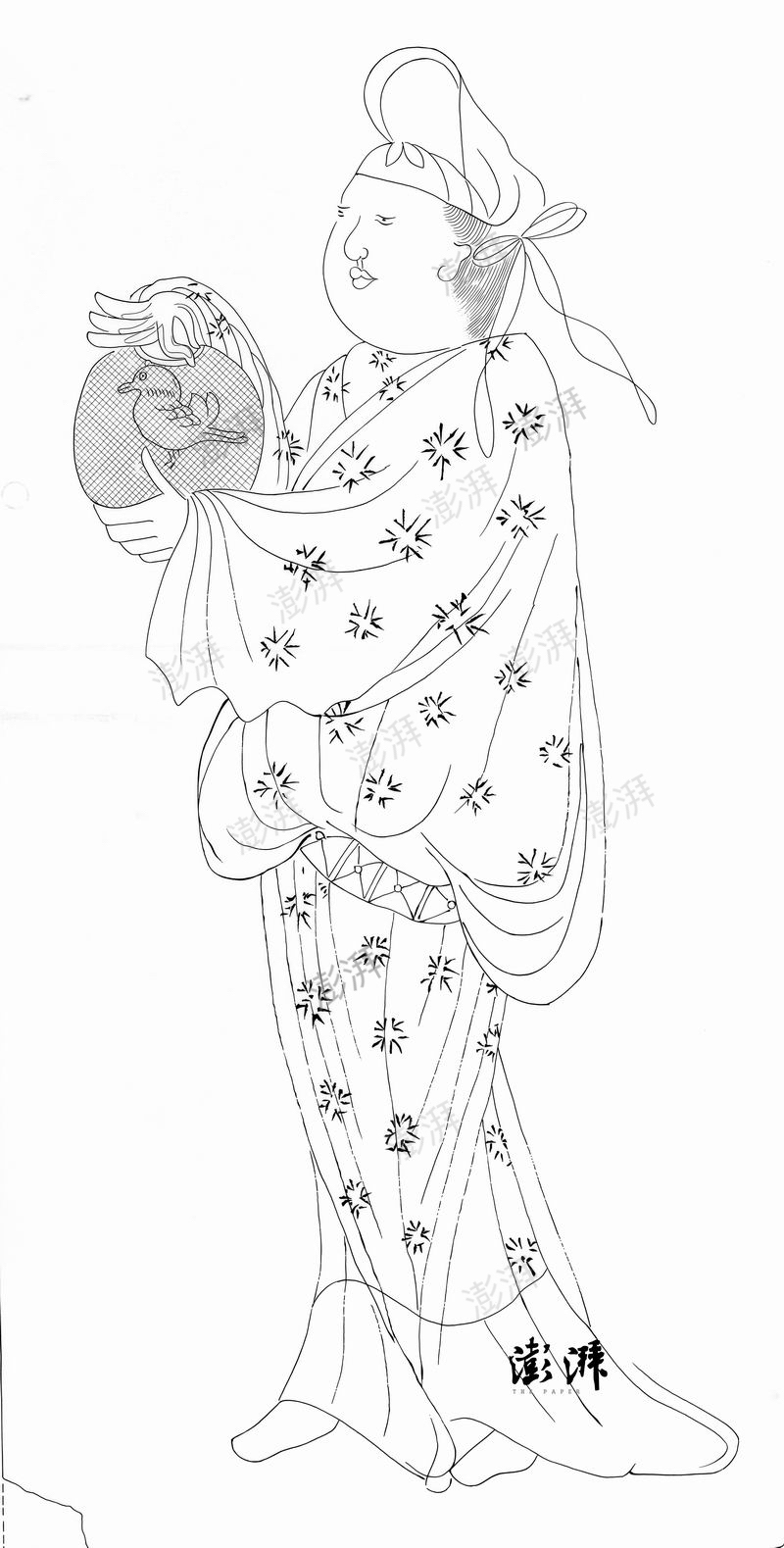
Figure 8: Ladies in men's clothing wearing high buns and headdresses, eyes slightly opened to look at rare birds, holding the bottom of the cage with their left hand, and lifting the gold wire cage with orchid fingers with their right hand.
Looking around, in the screen-style picture on the wall of the coffin, there are two ladies dressed in high buns, and six female figures wearing high buns on their heads. Whether they are ladies with higher family status or those who serve the lower class Maid, or Qin's daughter Yanji or Guan Luo's housewife, I am afraid that there is a misjudgment in terms of clothing. According to the general employment of aristocratic and senior official families in the Tang Dynasty, the ideal housemaid is not only beautiful in appearance, but also good at singing and dancing skills, and should be gentle and courteous. The formation of such characteristics and temperament is related to women's own social gender and male aesthetic needs. It has an inseparable relationship with the actual function of the family.
In the Tang Dynasty, officials and wealthy families often had maidservants in groups. According to their own conditions and the division of labor, they were divided into thick and thin, high and low. "Small servants" are upper-class maidservants with higher status. They are young, beautiful, intelligent, or have technical expertise, and are loved by their masters. Finely embroidered female celebrities, some even took charge of accounting affairs. Researcher Gao Shiyu has a special research on women's social class. She listed Tang Zhongshu Sheren Guo Zheng's family as a Koryo maid in charge of the property treasury, Hunan Observation made Li Yu's beautiful female slave in charge of the master's house and asked relatives, and supervised the censor Zhang Ji's family "can sing and dance, The maid of "Shan Shu Han" was in charge of documents, and Luzhou Jiedu envoy Xue Song's maid "good at playing Ruan, Tong Jing Shi" became the "internal record room" in charge of writing and writing. Calligraphy is strong. What is particularly noteworthy is that there are many people who are engaged in singing and dancing as family tricks. There are dozens of maidservants in the Meizhuang Pavilion in the courtyard of Guo Yuanzhen's residence. Xuanwu Jiedu made the two "favored slaves" of Li Qiangong's family both intelligent and good at playing the qin, as well as playing the zither and singing. Chen Xigu, the governor of Lianzhou, once invited Lianzhou, who was good at singing, to join the army. Song Zhiwen taught his maid to sing, and the maid mingled with him through the window. Therefore, the "little maids" in the families of high-ranking families or high-ranking officials are not cheap, and they have become capital for the master's family to show off.
Handmaids, female mouths, female singers, and female prostitutes were very common in families in the Tang Dynasty, and they had a strong color of personal attachment, often accompanied by activities such as buying, selling, contributing, bestowing, and transferring, with a forced result. Professor Ning Xin said, “Both government and private have a great demand for maidservants, musicians, prostitutes, etc. It is common for officials and wealthy families to have female musicians, dozens, dozens, or even hundreds of female musicians. Therefore, women often become Objects that are bought, sold, gifted, and robbed, due to the expansion of deformed luxury consumption, form a huge heterosexual consumer market, and women become the bulk of consumption." Although many poems describe the endless beauty of ladies and servants in high-end houses Some unearthed epitaphs also praised their tender and tender experience, but in fact, the fate of most house servants and maids in reality is probably humble and not so beautiful and infinite.
This set of stone screen paintings on the outer coffin wall has been buried underground for more than a thousand years, "hidden in the deep boudoir unknown", and now it has been unearthed and released to the public, realizing the effect of breaking the circle. Women, stand out in the unique style of lady Qiluo figure paintings.
2. Analysis of the characteristics of stone engraving and line drawing
Zhang Hu, a poet of the Tang Dynasty, said in his poem "Ti Wang You Cheng Shanshui Barrier": "The essence is in the pen, but the ingenuity is difficult to reach." The rich expressive style of the stone coffin line is not a random and disorderly pile, and every patterned design detail will emerge its origin of the times. The painters tried their best to create a home for dignitaries and dignitaries. Entering this "courtyard-style" garden, there will be a combined art of space. From the beginning to the end, it is like entering a coherent chapter and a story with continuous plots.
The group of maids under the expectation of male aesthetics in ancient times was often endowed with some idealized and specific characteristics, such as the characteristics of women's specialties, good at singing and dancing, charming appearance and gentle temperament. Respectful, submissive, and welcoming, it also integrates the traditional ethical discipline on women into the life trajectory of domestic servants and maidservants.
The artistic characteristics of the painting are:
First, from the perspective of the images of ladies, all the characters in the paintings are plump, round, with slender eyes and beautiful. "Qiaoxiaoqianxi, beautiful eyes looking forward to Xi". People in Tang Dynasty believed that people with skinny ridges were thin and skinny, and they couldn’t be a householder. Therefore, they preferred graceful appearance and leisurely manners. What they pursue is a kind of "gorgeous" beauty, that is, exposed and publicized healthy beauty. The epitaphs of women in Tang tombs often describe "sweet and graceful appearance, calm and prosperous"; According to Zhang Yanyuan's "Famous Paintings of Past Dynasties" recorded painters who were good at painting ladies, the ancient sayings of Tang Zhongzong and Zhou Yan were good at depicting women's appearance, and Zhang Xuan was good at painting women and prostitutes in Kaiyuan. Tan Zhen is good at painting beauties, beauties, operas and music, such as "Wu Hui Concubine Dancing Picture" and so on. Most of the women they painted are "thickness is the body, the meaning is thick and the attitude is far away, and the weak are few". and artistic style.
Second, from the point of view of women's hair buns, the development of women's fashion in the Tang Dynasty was gradually dominated by high buns. Even the emperor once asked why women loved to wear high buns. In the early Tang Dynasty, the palace people liked to comb the half-up bun, which evolved from the upturned lotus-style bun in the Sui Dynasty. Unearthed cultural relics in the early Tang Dynasty show that women's hairstyles at this time can be divided into low and high buns, and single and double buns. Influenced by the Buddhist snail necklace, the spirally coiled single snail and double snails, the startled swan bun based on the wings of a bird, and so on.
During the Kaiyuan and Tianbao years, the aesthetic style of plumpness was gradually formed, and the high bun, which became popular in the early Tang Dynasty, reached a peak at this time. Falling horse buns, Japanese buns, and righteous buns (false buns) are popular. Exquisite hairstyles with round and delicate cheeks and makeup are especially popular among women. Wen Tingyun's poem "Nangezi · Woqiu low bun" in the poem "Waoqiu combs a bun, and Lianjuan sweeps her eyebrows finely", is the portrayal of the Waqiu bun. The characteristic of its shape is that the hair is tied into a bun, and the bun hangs down from one side of the top of the head.
Compared with the bun most favored by aristocratic women in the Tang Dynasty after the middle and late Tang Dynasty, the two ladies combing their buns in the line depicting the stone coffin are obviously Japanese buns. The hairstyles combed by the nobles and the upper class in the early days became the fashion. Therefore, we can judge that the outer coffin walls of this set of stone inscriptions and line drawings are works of the Kaiyuan Tianbao period.
Thirdly, from the point of view of clothing characteristics, the women on the screen are dressed in two situations, one is the peony flower skirt with wide and wide sleeves, cross-neck gown, cross star skirt, and drape, and the other is the round-neck gown similar to men’s clothing Women in palace clothes are often referred to as "women disguised as men". "Old Tang Book" Volume Four and Five "Yu Fu Zhi" records the changes from the period of Tang Gaozong Yonghui (650~655) to the period of Empress Wu (684~704) from the curtain hat, the power fence, and the Hu hat. Palace riders all wear bearded hats, make-up and show their faces without any hindrance. The families of scholars and concubines follow suit. Humble inside and outside, this is consistent." The historical records are confirmed by the cultural relics of Tang tombs, such as the murals of Hu Fu's maid in the tomb of Princess Xincheng in Zhaoling in the fifth year of Xianqing, the murals of Hu Fu's maid in the tomb of Prince Zhanghuai in the second year of Shenlong (706), and the murals of Hu Fu's maid in the tomb of Prince Zhanghuai in the second year of Shenlong (706). Princess Yongtai The murals of Hu Fu's maids, the paintings of Hu Fu's maids in the tomb of Prince Jiemin in the first year of Jingyun (710), the murals of Hu Fu's maids in the tomb of Jinxiang County Lord in the 12th year of Kaiyuan, and so on. Whether it is a lady dressed in men's clothing or a maid dressed as a man, they all have a plump body, which is different from the fat and bloated after Tianbao, and has a new image of grace and beauty.
Fourth, it can be seen from the painting that the utensils are depicted. In the sixth picture, the maid plucks the guqin. There are seven qin pillars on the surface of the qin, forming a Big Dipper. This kind of Tangqin painters are very familiar with the characteristics of the instrument, so the sketch The posture and movement of playing the piano are very in place. The maid bowed her head and tilted her body, appearing to be quite comfortable playing the piano. Moreover, the artist accurately depicts the wooden square stool on which the maid sits. This kind of seat with hanging feet has appeared many times in Tang tombs. The painter pays great attention to the details, and the paintings are realistic, such as gold silk birdcages, ink ingots, etc., and only the cloth bag or brocade bag is used to protect the piano bag of the guqin, or the music score tube, calligraphy and painting tube, pen container, poem tube and other bag covers of the above.
Fifth, the artistic conception attaches great importance to all the movements of the characters. The maids play the piano, watch the birds with cages, release the birds with ropes, unfold the "Miscellaneous Collection" scrolls to appreciate calligraphy, carry the guqin on their shoulders into the garden, stand sideways and hold a staff to enjoy the flowers, etc. , are not images of delicate and weak women. In order to create the landscape environment of the house and mansion, old trees with dead branches, flowers and grasses, flying butterflies, stems and petals are depicted on the screen, especially to highlight the spirituality of flowers and birds. There are not only birds with ribbons in their mouths, but also The mandarin ducks look at each other and hold the grass alone, and they are all arranged on the screen with ribbons.
When Yuan Zhen, a famous literati in the Tang Dynasty, visited eastern Zhejiang, he wrote a poem praising Liu Caichun, a local embroiderer girl, "the new make-up is ingenious and painted with double moths, and the mantle is wrapped in Hengzhou Tueruo. The front is smooth and smooth, and the wrinkled literary boots are lightly stepped on slowly. Words Yacuo is graceful, and his manners are humble and charming." After the Song Dynasty, literati believed that arranging nymphs, flowers and plants around ladies can increase the attraction to the opposite sex, making them graceful and seductive. The tradition of the Tang Dynasty believed that the fragrance of flowers and plants has the effect of eliminating evil and avoiding filth. The painter used plants to mimic the natural characteristics and used flying butterflies to describe growth and transformation, implying to create a beautiful three-dimensional impression of women in terms of vision and smell.
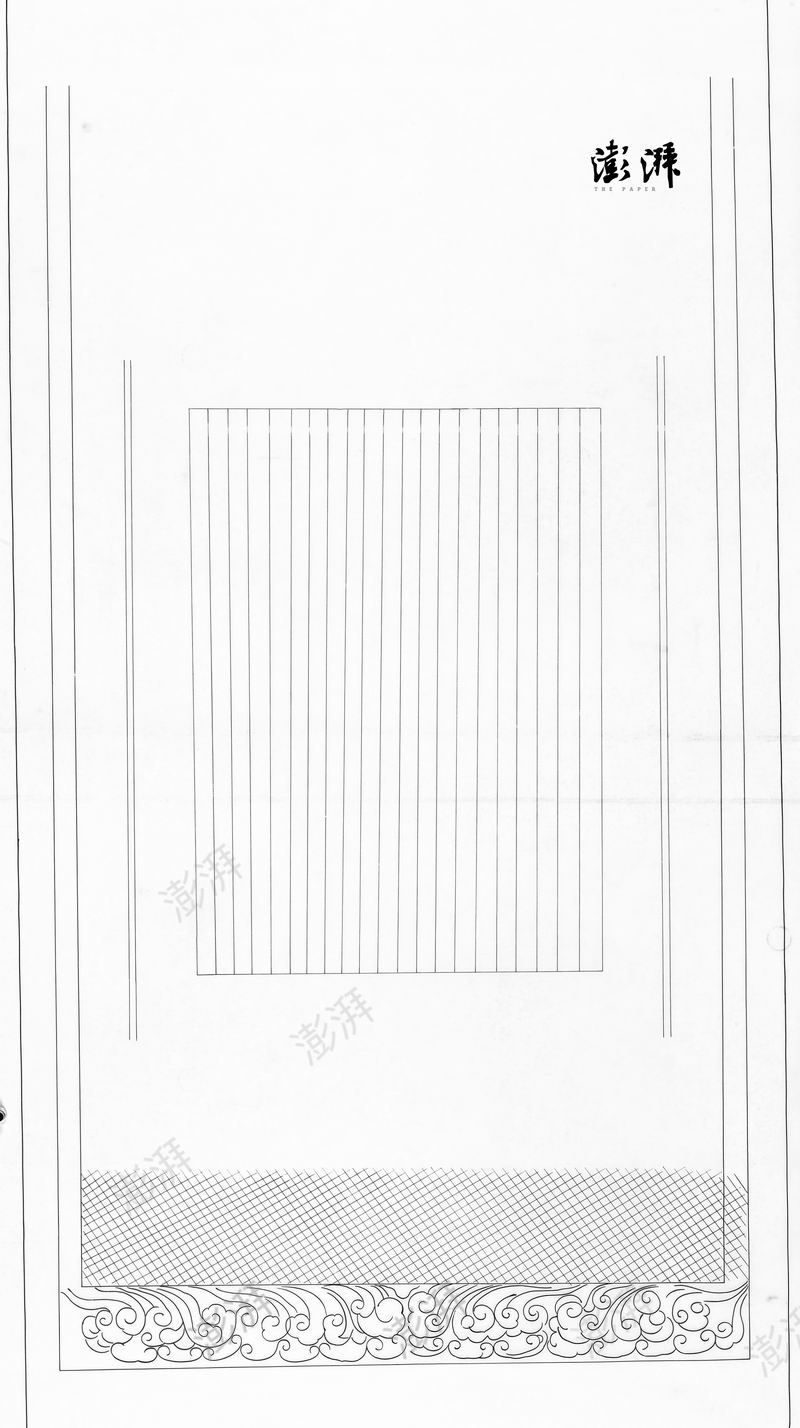
Figure 9. The engraving of net pattern and cirrus moiré pattern under the mullion window of the outer coffin wall was not completed after drafting.
It is worth pointing out that although the whole set of stone screen paintings is perfect, judging from the remaining works on the coffin wall, some details still make people puzzled. The fringe decoration of clothing, and the cuffs, plackets, collars, etc. of women's clothing in the paintings of ladies found in the tomb murals of the same period are very fashionable. In addition, the top of the other side of the outer coffin wall is carved with water wave moiré, and the first layer of moire is also carved with oblique net pattern, and there are lattice windows carved in the middle (Fig. 9).
3. The detailed imagination brought about by the depiction of the coffin wall lines
Du Mu's "Pingfeng Quatrains" said: "The screen Zhou Fang painted a slender waist, and the blue color is half lost after a long time. Leaning against the jade window, the girl with a luan hair, the Buddha dust is still jealous of herself." The poems on paintings in the Tang Dynasty used line drawing to praise the paintings at that time. This historical background and artistic environment provide us with important conditions for interpretation. What is commendable is that the painters of the Tang Dynasty did not have a unified, rigid, and labeled paradigm. They often depicted the diversity of individuals with the observation of real life. Many details, not limited to the character itself, better portray the dynamics of the characters.
The new depiction of the coffin wall opens a garden gate that we have never set foot in, and we have a new look at the familiar aristocratic family described in the past. Compared with the previous depictions of the tomb of Prince Yide, the tomb of Princess Yongtai, the tomb of Wei Li, the tomb of Wei Xu, the tomb of Xue Jing, etc., although the screen paintings have independent spaces and unique characters in each work, they have constructed our imagination. The world of Chinese and magnificent private mansions. Through these pictures, we found that each specific space connects the ups and downs of the storyline, showing the maids admiring cursive calligraphy, playing the seven-star guqin, watching the canary in the birdcage, standing alone and singing in the garden, etc. Each picture has to switch the perspective, giving people a different feeling, and the context of the image is very clear. Judging from the space divided according to the screen paintings, the depiction of the lattice windows on the outer wall of the last stone coffin has a special sense of residential realism.
In the past, it was said that Zhang Xuan painted "White Parrots of Taizhen Teaching", and Zhou Fang painted "White Parrot Practices Shuanglu", etc. The scrolls have long been lost, and they are all recorded in documents. Archaeological unearthed murals and pottery The figurines also hold parrots or long-tailed birds in their hands, and at most they hold big birds. As for the golden birdcage described in literary works, we have not seen the actual image. Wei Zhuang's "Qin Fu Yin" "The year before last, on the fifth day of the twelfth lunar month, the golden cage was closed to teach parrots. Open the luan mirror to comb your hair lazily, and carve The column is silent." Moreover, literature describes that noble ladies and concubines are closed in courtyard houses, which is likened to birds in golden cages. This time, I really observed the birdcage through the stone carving line drawing. It doesn't matter whether the canary bird is closed or not, the key is to see the real situation of the maid raising and amusing the bird at that time.
Among the eight line depictions, six maids wear soft-footed headdresses, and four of them wear round-necked robes with leather belts around their waists. The masculinity of women is particularly prominent. "New Book of Tang" volume three and four "Wu Xing Zhi" records that "Gao Zong tasted the inner banquet, Princess Taiping's purple shirt, jade belt, soap Luo folded the upper towel, and performed seven things, singing and dancing in front of the emperor. The emperor and Empress Wu laughed and said: Women are not allowed to be military officers, so why should they dress up for that?" The "folding scarf" mentioned here is the Futou, and the "Fun Li Qi Shi" refers to the knives and pockets attached to the belt on the belt, also known as "the belt". . Princess Taiping deliberately dressed up in men's clothing at the banquet, which is the "fashionable clothing" that is also popular in the court. These aristocratic women are well-dressed and live a good life. Even if the gender of women is downplayed, their uniqueness is still an important reason to attract viewers.
Mr. Sun Ji once pointed out that "women disguised themselves as men" appeared as Hufu for women in the Tang Dynasty, especially the inner court courtiers liked to wear round-neck gowns in men's uniforms. Awakening is also a challenge to the traditional patriarchal society”, but this kind of argument is not supported by archaeological data, it is just the fantasy of modern literati. For women in the Tang Dynasty, wearing Hufu and men's clothing only brought convenience, rather than elegant and luxurious women's yearning.
What deserves our attention is that before the prosperous Tang Dynasty, there was often a strong Huhua style in the paintings of ladies. Ladies wearing muddy hats, lapeled Hu suits, and Hu boots appeared frequently, but this set of stone coffin screen paintings did not appear. There are no maids in Hu suits, and no women disguised as men in "gowns and hakamas". Tang Xuefeng's poem "Gong Ci" "Looking at the opening of the curtain of the main hall, the palace people in robes and hakamas sweep the imperial bed". Mr. Sun Ji instructed the author to pay attention to the difference between the women in skirts and those in "pao and hakama" and Hu clothes in the murals and line drawings, and pay attention to the position of women in Hu clothes when a row of women appeared in the tomb. There are different symbols on the clothes of the lower class maids.
Painters in the Tang Dynasty often fell into the stereotype of gender prejudice when portraying female characters. Most of them were delicate, beautiful and dependent women. They rarely portrayed gentle, generous and understanding women positively. , the Tomb of Princess Yongtai, the Tomb of Li Hui, the Tomb of Wei Wei, the Tomb of Ashina Huaidao, etc., the various women seen in the stone coffin line depictions are often dignified and straight-faced. The women in the costumes have different faces and are not the same. Some cute and cute images not only create a variety of women, but also deduce their social status and career choices. It should be said that the painter's materials were deeply rooted in the homes of dignitaries and nobles, and were close to the life of the nobles at that time, so they have the original shape of real life, and the line paintings carved on hard stones have texture and warmth. The Five Dynasties "Han Xizai Evening Banquet" vividly depicts Han Xizai's dancing green waist. The time is not far from the original appearance in Tang Dynasty, so it can also be used as a reference.
The ideal private women in the Tang Dynasty had beautiful appearance, soft temperament, talent in poetry and prose, and superb music and dance skills. The painters depicted these women's appearance in the prosperous era. People did not pay as much attention to their music and dance skills, because even if they were ordinary in appearance, they were good at music, dance, poetry and other talents. The ladies in China are favored by the scholars, so when the painters create their paintings, they are full of imagination towards beauty. The most obvious feature is that on one side they show their fullness and beauty, and on the other side, the garden is full of endless tricks. Le Yayi, poems and chapters. As for some scholars, whether this kind of theme of ladies is related to Afrasiab in Uzbekistan (Afrasiab, the capital city of Kang State) (Chinese history books call it Kang Judi, Xi Wanjin, Kang Guo, Sa Mojian, and Samadan) , Ancient Greece called Maracanda (Maracanda) mural "Phoenix Shouzhou" women in Tang suits, or some people suggest that women in the Tang Dynasty believe that fat is the origin of Kang women, which need further comparison and discussion.
Du Fu said in the poem "Dan Qing Yin Presents General Cao": "The edict says that the general brushes the plain silk, and the artisan is in dismal operation." Mastery of painting skills. Of course, the interpretation and interpretation of these line drawings cannot be separated from the construction of bridges newly discovered by cultural relics, and cannot be separated from the understanding of the background of that era. The soft power of painting art comes from the hard foundation of historical accumulation.
(This article is the special achievement of the 2020 National Social Science Fund's unpopular study "Research on the Civilization Attributes of Foreign Images of Dunhuang Murals". The author is a distinguished professor of the Advanced Research Institute of Humanities and Social Sciences of Shaanxi Normal University and a part-time researcher of the Silk Road Collaborative Innovation Center of the Central Academy of Fine Arts. The original text of the article Published in the second issue of "Art Research" in 2023. When The Paper was authorized by the author to republish, the annotations were not included. The original title was "Women in the Garden of the Mansion in the Tang Dynasty——A Study on the Screen Lines of Xinjian Coffin Wall")
